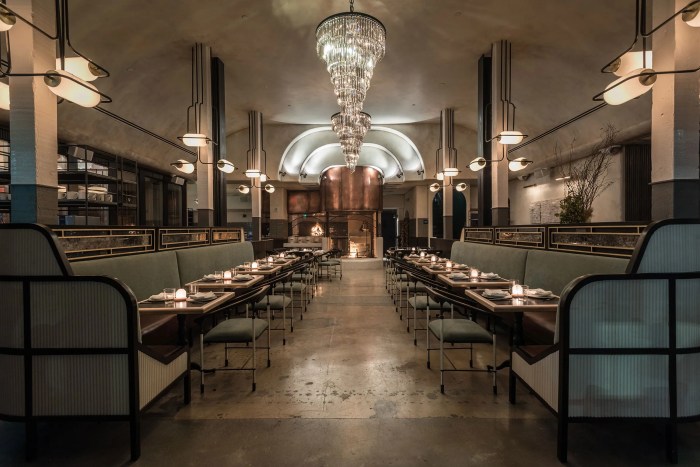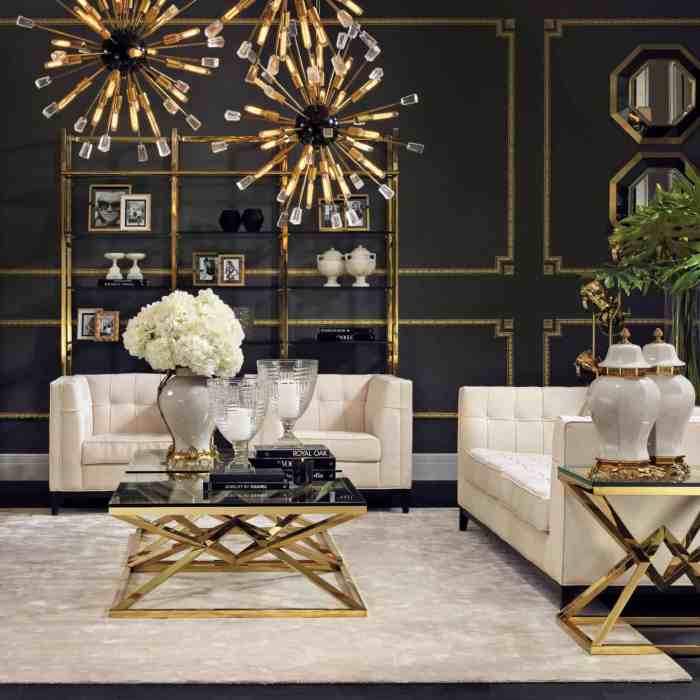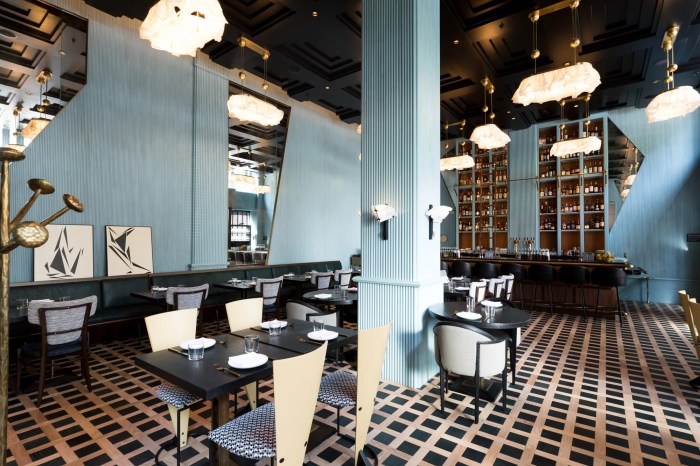Art Deco Revival: Glamorous Details for Luxe Interiors unveils the resurgence of Art Deco’s captivating aesthetics, exploring its influence on contemporary design and offering practical tips for incorporating its opulent charm into your home.
From the living room to the bathroom, discover how geometric patterns, metallic accents, and luxurious fabrics can transform your space into a glamorous haven. Learn the art of balancing Art Deco elements with other design styles, creating a harmonious and visually stunning interior.
Art Deco Revival: A Resurgence of Glamor

Art Deco, a captivating style that flourished in the 1920s and 1930s, is experiencing a remarkable resurgence in contemporary interiors. This iconic style is characterized by its bold geometric forms, luxurious materials, and opulent details.The resurgence of Art Deco can be attributed to several factors.
Firstly, there is a growing appreciation for the glamour and sophistication of the era. Secondly, contemporary designers are drawn to the style’s versatility, which allows it to be seamlessly integrated into various design schemes.
Key Art Deco Elements Making a Comeback
Several key Art Deco elements are making a significant comeback in contemporary interiors:
Geometric Patterns
Bold geometric patterns, such as zigzags, chevrons, and sunbursts, are a hallmark of Art Deco style. These patterns are often used in fabrics, wallpaper, and architectural details.
Metallic Accents
Metallic accents, such as gold, silver, and bronze, add a touch of luxury to Art Deco interiors. These accents can be found in furniture, lighting fixtures, and decorative objects.
Rich Materials
Art Deco interiors often feature rich materials, such as velvet, silk, and leather. These materials add a sense of opulence and comfort to the space.
Streamlined Forms
Streamlined forms, which evoke a sense of speed and modernity, are another defining characteristic of Art Deco style. These forms can be found in furniture, lighting fixtures, and even architecture.
Incorporating Art Deco Details into Your Home

Incorporating Art Deco elements into your home can add a touch of glamour and sophistication. Here are some ideas for adding Art Deco touches to different rooms:
Living Areas:
- Use geometric patterns on furniture, rugs, and curtains.
- Add metallic accents with lamps, mirrors, and sculptures.
- Choose luxurious fabrics like velvet, silk, and satin for upholstery and curtains.
Bedrooms:
- Use a headboard with a geometric design.
- Add a metallic nightstand or dresser.
- Hang a chandelier with Art Deco details.
Bathrooms:
- Use geometric tiles on the floor and walls.
- Add a metallic mirror or vanity.
- Install a showerhead with an Art Deco design.
When incorporating Art Deco elements into your home, it’s important to balance them with other design styles. Too much Art Deco can feel overwhelming, so use it sparingly and mix it with other styles to create a cohesive look.
Furniture and Decor Inspired by Art Deco: Art Deco Revival: Glamorous Details For Luxe Interiors
Art Deco’s influence extends beyond architecture into the realm of furniture and decor. Iconic pieces from the era are characterized by their bold lines, geometric shapes, and luxurious materials.
Furniture
Signature Art Deco furniture pieces include:
- Club chairs: Upholstered in rich fabrics like velvet or leather, with curved backs and tapered legs.
- Sofas: Long and low with geometric patterns or tufting.
- Cabinets: Made from exotic woods like ebony or rosewood, with stepped or ziggurat-shaped designs.
- Side tables: Featuring round or rectangular tops supported by chrome or glass bases.
- Lighting: Art Deco lamps often have geometric shades made from glass or metal, with intricate detailing.
Materials
Art Deco decor embraces materials that reflect the era’s opulence and modernity:
- Chrome: Used for its shiny, metallic finish, adding a touch of glamour.
- Glass: Clear or colored glass was employed for tabletops, lighting, and decorative objects.
- Lacquer: Applied to furniture and accessories, lacquer created a high-gloss finish in vibrant colors.
Contemporary Designers
Contemporary designers are reinterpreting Art Deco motifs in their work:
- Kelly Wearstler: Known for her bold use of geometric patterns and luxurious materials.
- Jonathan Adler: Incorporates Art Deco elements into his eclectic designs, with a focus on color and whimsy.
- Tom Dixon: Blends Art Deco influences with industrial aesthetics, creating modern and edgy pieces.
Art Deco Revival in Lighting and Accessories

The Art Deco revival is not just limited to furniture and decor; it also extends to lighting and accessories. Lighting fixtures and accessories from this era are characterized by their geometric shapes, bold colors, and opulent materials.
One of the most iconic Art Deco lighting fixtures is the chandelier. Chandeliers from this era are often made of metal or glass and feature geometric shapes such as circles, squares, and triangles. They are also often decorated with opulent materials such as crystal and brass.
In addition to chandeliers, other popular Art Deco lighting fixtures include sconces, table lamps, and floor lamps. These fixtures are often made of the same materials as chandeliers and feature similar geometric shapes. They can be used to add a touch of Art Deco glamour to any room.
Art Deco accessories are also a great way to add a touch of glamour to your home. Popular Art Deco accessories include vases, sculptures, and mirrors. These accessories are often made of materials such as glass, metal, and ceramic. They can be used to add a touch of Art Deco style to any room.
Tips for Incorporating Art Deco Lighting and Accessories into Your Home Decor
- Start by choosing a few key pieces that you love. This could be a chandelier, a sconce, or a table lamp. Once you have a few pieces, you can start to build your collection.
- Don’t be afraid to mix and match different styles. Art Deco can be paired with other styles, such as mid-century modern or contemporary. This can create a unique and eclectic look.
- Use Art Deco lighting and accessories to add a touch of glamour to any room. These pieces can be used to create a focal point or to add a touch of personality to a space.
The Impact of Art Deco on Contemporary Art and Design

Art Deco’s influence on contemporary art and design is undeniable. Its geometric patterns, bold colors, and luxurious materials have been reinterpreted and incorporated into a wide range of modern creations. From architecture to fashion, painting to sculpture, Art Deco motifs and principles continue to inspire and captivate.
paragraphContemporary artists and designers are drawn to Art Deco’s sleek lines, geometric shapes, and opulent materials. They use these elements to create works that are both visually striking and timeless. Art Deco’s emphasis on functionality and luxury also resonates with modern sensibilities, making it a popular choice for interior design and product design.
Architecture
In architecture, Art Deco’s influence can be seen in the design of skyscrapers, hotels, and other public buildings. These structures often feature geometric facades, stepped roofs, and decorative details such as chevrons and zigzags. Contemporary architects have adopted Art Deco elements into their designs, creating buildings that are both modern and evocative of the past.
Fashion, Art Deco Revival: Glamorous Details for Luxe Interiors
Art Deco’s impact on fashion is evident in the use of geometric patterns, bold colors, and luxurious fabrics. Designers such as Coco Chanel and Elsa Schiaparelli were influenced by Art Deco, and their designs continue to inspire contemporary fashion collections.
Today, Art Deco motifs can be found on everything from clothing to accessories, adding a touch of glamour to any outfit.
Painting and Sculpture
Art Deco’s influence can also be seen in painting and sculpture. Artists such as Tamara de Lempicka and Diego Rivera incorporated Art Deco elements into their work, creating paintings and sculptures that were both modern and decorative. Contemporary artists continue to draw inspiration from Art Deco, creating works that explore the relationship between art and design.
End of Discussion
The Art Deco revival continues to captivate the world of interior design, offering a timeless elegance and a touch of extravagance. By embracing its iconic motifs and principles, you can create a home that exudes sophistication and glamour, a true reflection of the enduring legacy of Art Deco.
Quick FAQs
What are the key characteristics of Art Deco style?
Art Deco is known for its geometric patterns, bold colors, and luxurious materials, often incorporating chrome, glass, and lacquer.
How can I incorporate Art Deco elements into my home without overwhelming the space?
Start by adding small touches, such as geometric throw pillows or metallic accents. Gradually introduce larger pieces, such as a statement chair or an Art Deco-inspired light fixture, while balancing them with more neutral elements.
What are some contemporary designers who are incorporating Art Deco influences into their work?
Designers like Kelly Wearstler, Jonathan Adler, and Tom Dixon have embraced Art Deco motifs, reinterpreting them in modern and eclectic ways.
